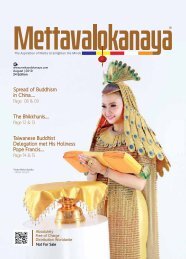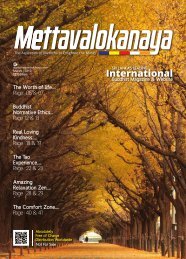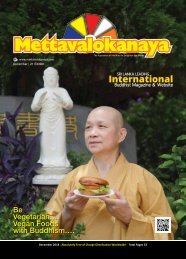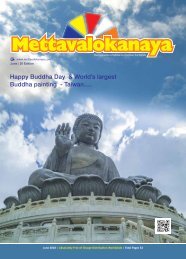mettavalokanaya_buddhist_magazine_january_2021.
This is the Sri Lankan's Most Popular & Leading Monthly International Buddhist Magazine, “Mettavalokanaya” on January - 2021 Edition - 30. “Mettavalokanaya” International Buddhist Magazine has been successfully distributed to 40 countries worldwide. Specially distributed to Overseas High Buddhist Monks, Masters, Nuns, Worldwide famous Buddhist Monasteries & Associations, International Buddhist conferences and Forums. “Mettavalokanaya” International Monthly Buddhist Magazine has been awarded as the “2018 - The Global Buddhist Ambassador Award” from Thailand as the World’s Best and Most popular Buddhist Magazine. The Mettavalokana Buddhist Publications Centre is a registered Buddhist Publications Centre in Sri Lanka and has received many International accolades. Our publications are absolutely free of charge to general public. The magazine comprises of special articles on Buddhism written by leading Buddhist Monks from foreign countries. “Mettavalokanaya” is currently been published in English and includes full color 60 pages.
This is the Sri Lankan's Most Popular & Leading Monthly International Buddhist Magazine, “Mettavalokanaya” on January - 2021 Edition - 30. “Mettavalokanaya” International Buddhist Magazine has been successfully distributed to 40 countries worldwide. Specially distributed to Overseas High Buddhist Monks, Masters, Nuns, Worldwide famous Buddhist Monasteries & Associations, International Buddhist conferences and Forums. “Mettavalokanaya” International Monthly Buddhist Magazine has been awarded as the “2018 - The Global Buddhist Ambassador Award” from Thailand as the World’s Best and Most popular Buddhist Magazine. The Mettavalokana Buddhist Publications Centre is a registered Buddhist Publications Centre in Sri Lanka and has received many International accolades. Our publications are absolutely free of charge to general public. The magazine comprises of special articles on Buddhism written by leading Buddhist Monks from foreign countries. “Mettavalokanaya” is currently been published in English and includes full color 60 pages.
Create successful ePaper yourself
Turn your PDF publications into a flip-book with our unique Google optimized e-Paper software.
Finding Venerable
Mother….
“The Goal of
Buddhism”….
We cannot solve anything
by anger. Anger doesn’t
lead us anywhere. It is
more difficult to practice
compassion and loving-kindness. That is
the goal of Buddhism.” - The statement
was made by Most Venerable Bhikkhuni
Dhammananda (Dr.Chatsumarn
Kabilsingh), The Chief Abbes -
Songdhammakalyani Bhikkhuni Arama
and The Medicine Buddha Vihara,
Nakhonpathom, Thailand. This is the
meaningful story with Most Venerable
Bhikkhuni Dhammananda for Finding
Venerable Mother….
The next day was the ordination
ceremony. We meditated and chanted
together, as we’d done each morning
at five thirty. About eight o’clock, we
gathered to take our places in line.
Dressed in white, we carried three lotus
blossoms and walked in procession,
circling the Medicine Buddha Vihara
three times. Then we gave the lotus
blossoms to the bhikkhunis who stood
on the lower steps of the vihara. We
entered the Vihara to recite a special
prayer. The Thai women had memorized
the entire recitation. I had a phonetic
transcription of the words in English
in order to be able to sound them
out. I didn’t memorize all the verses
since there wasn’t time for it. Instead,
I concentrated on memorizing two
key phrases. The first phrase asked for
Dhammananda to protect and take care
of me, and the second asked for her
forgiveness. Chanting along with the
others, I felt rooted in my commitment
to be ordained and in my devotion to
Dhammananda.
Following the recitation, we bowed
one by one before Dhammananda, and
walked out of the vihara to a small
wooden shed behind the shrine. It was
chaotic inside as 124 women struggled
to change out of their white clothing
into saffron robes. Fortunately, we had
the help of temple volunteers, who
urged us to change quickly. We had
been shown how to fold the sanghati
(saffron sash), but I was nervous and
couldn’t get the folds quite right. Luckily,
one of the novice nuns came to help
me press the layers of fabric together
so it draped neatly over my shoulder.
Smoothing and patting me down,
she adjusted my sash until it was just
right. Once outside, we each received
our alms bowls from a trusted family
member—in my case, the same Thai
woman who had partnered with me
earlier. Then we received our ordained
name; mine was Dhammanandiya. I
later asked Dhammananda to translate
the meaning for me. She explained that
Dhamma referred to the teachings of
the Buddha. Nanda was the name of
the princess who was the daughter of
Maha Pajapati, the first woman to be
ordained in the Buddha’s time. Taken
together, the name meant “She who
takes pleasure in the Dhamma.” I was
proud of my name; it sounded like
Dhammananda only with a different
ending. Like mother, like daughter, I
thought. This marked the end of the
ordination ceremony.
Everyone gathered at the front
entrance of the temple, smiling, taking
pictures, and admiring their new robes
as if we were one happy family. I was
elated to feel so close to all the Thai
women; it was the feeling I’d longed
for from the beginning. I trusted my
sisters in the Dhamma, shining bright
in their new robes. When I came home,
I felt stronger, with a new sense of
confidence born from my ordination
experience, as if I had undergone a
ritual rite of passage and emerged a new
woman. I hadn’t realized it at the time,
but looking back at the ceremony, the
moment I knelt before Dhammananda
and started to sob was a life-changing
experience. The feelings came on so
fast that it was all I could do to make
sense of the process. My heart, which
had been hardened and closed for so
long, cracked open. All my childhood
pain and sadness came tumbling out.
Dhammananda’s profound love had
touched me to my core. When she took
my hands in hers, it was as if she were
ministering a sacred benediction. I felt
her warmth and caring like a soft glove
against my face. All my life I had wanted
my parents’ blessing. Dhammananda’s
unconditional love gave me the
permission I had been seeking to let go
of my self-hatred and resentment. She
was the nurturing mother I had always
yearned for.
Over the previous nine years,
Dhammananda had been sowing seeds
of compassion in my soul, but it was
only in that breakthrough moment,
when I bowed before my teacher, that
I truly understood what she meant. It
was the embodiment of an idea that
Dhammananda had been laying the
groundwork for all along—to learn to
love myself. Loving myself helped pave
the way to forgiving my mother.
In the month following my
ordination, I began to think about my
mother’s life in context. She didn’t
appear to have had a close relationship
with her own mother, who was older
and spoke no English. I had the feeling
that my mother, like me, had been left
on her own growing up. She’d never
told me she felt lonely or neglected as a
child, but I had the sense that she never
felt loved. As I came to understand
the complexity of my mother, I began
to appreciate her for who she was.
Part of my healing process had been
to quell the angry voices in my head,
to open my heart and empathize with
my mother’s situation. I thought about
what Dhammananda said when I first
met her: “We cannot solve anything
with anger. Anger doesn’t lead us
anywhere. It is more difficult to practice
compassion and loving-kindness. That is
the goal of Buddhism.”
Dhammananda’s love helped me
come full circle. If my mother were
alive today, I would tell her how much
I loved her, how much she inspired me,
and how much she meant to me. There
are few relationships more important
than that between a daughter and
her mother. Once that is healed,
we gain our birthright as women.
Dhammananda allowed me to heal
my relationship with my mother, to
learn to accept myself, and to become
the whole person I was meant to be. I
was grateful to Dhammananda, who
had so generously taken me into her
inner circle and honored my presence
with her love and compassion. I carried
the love of my teacher as a constant
reminder to be true to myself and speak
from the heart. I am eternally grateful
to Dhammananda and always will be.
USA
Cindy Rasicot
34 l Mettavalokanaya l January l 2021 2021 l January l Mettavalokanaya l 35
















